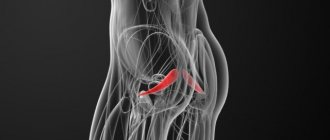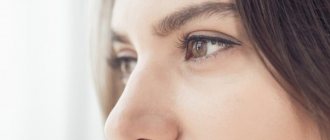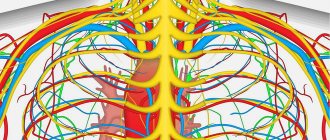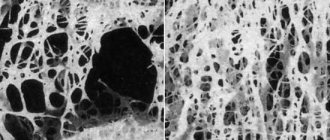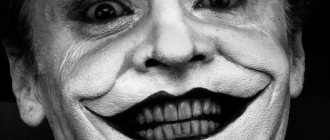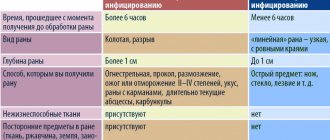Causes of hypertonicity of the masticatory muscles
As a rule, tension in the masticatory muscles is an expression of general mental stress. Remember the expression “gritting your teeth.” Endures, gritting his teeth or makes his way through obstacles, gritting his teeth, etc. And also: grinding, grinding his teeth out of anger or powerlessness.
The jaw clenches in situations involving the need to defend or compete. But in case of psychological shock, confusion, experience of failure or loss, the muscles relax. In such cases they say: “the jaw dropped.” Daily stress associated with work, business, family matters, etc. can cause hypertonicity of the masticatory muscles.
On the other hand: joy, smile and laughter, pleasure and love relieve tension by relaxing the jaw.
Changes in other parts of the body also provoke hypertonicity, most often this is a pathology of the cervicothoracic spine.
The incorrect position of the cervical vertebrae disrupts the symmetry of the face, the chin moves forward, which causes compensatory tension in the masticatory muscles. Malocclusion, treatment at the dentist, etc.
Tension of the muscles of the eyes and neck during prolonged work at the computer also involves the masticatory muscles in this process. Prolonged and frequently repeated exercise can cause hypertension. Hypertonicity leads to muscle shortening, compression of the skull bones, the formation of nasolabial folds and other sagging skin, and problems with the temporomandibular joint - TMJ.
What to do if your jaw cramps?
The treatment method depends on the true cause of this condition. Therefore, you first need to undergo a diagnosis from a neurologist, therapist, dentist, surgeon, orthopedist and other specialists.
So, if the jaw is cramped for dental reasons, then the following methods are used:
- grinding teeth, using removable and non-removable orthopedic structures to correct malocclusion;
- carrying out orthodontic correction using braces;
- osteotomy of the jaw - surgical elimination of violations;
- splint therapy.
On the subject: Strengthening the muscles of the esophageal opening of the diaphragm
If the cause is a jaw injury, then it is first necessary to exclude its fracture or subluxation using x-ray diagnostics. Sometimes microtrauma can only be detected on CT scans. The patient is prescribed rest and cold for the first 2 days, the jaw is immobilized using bandages.
During the recovery period, the following physiotherapy procedures are used:
- reflexology using electropuncture, laser puncture, and ultrasonic puncture methods;
- exposure to an ultra-high frequency (UHF) electric field;
- myoelectric stimulation - the use of electrical current pulses to restore the activity of muscle fibers;
- magnetic therapy;
- dry heat;
- electrophoresis and ultraphonophoresis with the use of drugs (potassium iodide, hydrocortisone);
- physical therapy and massage (a set of exercises is described below).
With the development of infectious arthritis, antibacterial drugs and physiotherapy are used. When bone adhesions form, conservative treatment methods are prescribed at the first stage (phonophoresis with hydrocortisone, electrophoresis with lidase, potassium iodide).
If there is no effect, then they resort to surgical intervention, which is carried out in hospitals in the departments of maxillofacial surgery.
If the cause lies in bruxism, then it is necessary to undergo consultation and treatment with a neurologist and neuropsychiatrist. Also, to prevent premature tooth wear, you need to visit a dentist, who can recommend orthopedic treatment methods.
If the jaw cramps due to muscle spasms, then several treatment methods are used:
- medications (painkillers and antispasmodics, antidepressants and tranquilizers to relieve tension);
- physiotherapeutic treatment (magnetic therapy, reflexology, laser therapy, dry heat);
- to consolidate a positive result - massage, relaxation, myogymnastics.
If there is concomitant osteochondrosis, the neurologist may prescribe massage of the cervical-collar area, physical therapy, and physiotherapy. During the treatment period, in all cases, trauma to the jaw should be avoided: avoid rough food, do not open your mouth wide, and avoid intense sports.
Massage
Self-massage for diseases of the temporomandibular joint is carried out according to the following method:
- Using gentle circular movements, stretch the trapezius muscle at the level of the shoulders and base of the neck.
- Then, continuing the massage, slowly lower your hands along the spinal column as far as possible.
- Turn your head, stretch the sternocleidomastoid muscle with your fingers, first on one side, then on the other.
- Place the thumbs of both hands under the lower jaws and massage the masticatory muscle in a circular motion, while simultaneously kneading its upper part on the cheeks using the remaining fingers.
This complex allows you to relax your muscles. Afterwards, it is recommended to do the exercises described below.
Warm and cold
In the first day after injury, as well as in the presence of acute pain in the jaw, you can use cold compresses. To do this, use ice wrapped in a towel or plastic bottles with cold water.
This helps block the transmission of impulses along nerve fibers and reduce pain. A cold compress should be applied to the temporomandibular joint for 5-10 minutes. several times during the day.
To more quickly stop the inflammatory process, thermal procedures are used. To do this, you can use a heating pad or a towel soaked in hot water. The compress is applied to the sore spot for 15-20 minutes. Heat also helps relax tense muscles in the area.
Relaxation
Reduces cheekbones and jaw (the reasons may be harmless), often due to overstrain of the facial muscles. To eliminate this condition, you can use the following set of exercises (perform each type of movement 10 times):
- Lightly press the pads of your fingers against the temporomandibular joint. Gently move your jaw left and right.
- Then move your jaw back and forth. These movements should not cause discomfort.
- After this, make circular movements with your jaw, first in one direction, then in the other (5 approaches each).
- Close your teeth and lips, smile, then purse your lips, stretching them forward.
- Relax your lower jaw so that it goes down. In this case, you need to apply a little pressure with your fingertips in the lower part of the cheeks.
- Also, in a relaxed state, exhale air.
- Make a semicircle with your head, first in one direction, then in the other, stretching the neck muscles.
All exercises must be performed with a straight back. They help with muscle pain, tension and spasms of the chewing and facial muscles.
Drugs
The main groups of medications used for this disorder are described in the table below.
| Name | Main effect | Dosage for adults, mg per day | Average price, rub. |
| Drugs affecting neuromuscular transmission | |||
| Miolastane (Tetrazepam) | Regulation of the functions of the central and autonomic nervous system | 25-50 | 200 |
| Ixel (Milnacipran) | 50 mg 2 times | 1600 | |
| Fluoxetine | 20 | 80 | |
| Angioprotectors
| |||
| Venoruton | Improving metabolic and reparative processes in bone tissue, intraosseous circulation | 300 mg 3 times a day | 1300 |
| Troxevasin | 500 | ||
| Pentoxifylline | 200 mg 2 times a day | 300 | |
| Chondroprotectors | |||
| Structum | Improving metabolic processes in cartilage tissue, increasing its resistance to damaging enzymes | 500 mg 2 times a day | 1600 |
| Inoltra | 3.8 g 3 times a day | 4000 | |
| Honda | 0.5-1 g 3 times a day | 250 | |
| Vasodilators | |||
| Papaverine | Improving peripheral blood circulation, relieving facial muscle spasms | 0.02 g | 45 |
| No-shpa | 40-80 | 160 | |
| A nicotinic acid | 1% solution, 5-7 ml (intravenous) | 50 | |
| Nonsteroidal anti-inflammatory drugs
| |||
| Ketonal | Reducing inflammation in arthritis, arthrosis | 100-200 (topically, in the form of a gel) or orally 25 mg 2-3 times a day | 100 |
| Diclofenac | 70 | ||
If the pain is very severe, then Berchet (Egorov) blockades are used using a 1-2% solution of Novocaine (Lidocaine). They are given as injections once every 3 days.
Folk remedies
Among the folk remedies for this condition, the following sedative recipes are used to help relax the facial muscles:
- Valerian root tea. 1 tsp. chopped roots pour 1 tbsp. boiling water, leave for 10 minutes. and take as tea 2-3 times a day. This remedy is not recommended for people suffering from liver disease and pregnant women.
- Motherwort decoction. Pour 15 g of herb into 250 ml of boiling water, add sugar to taste and bring to a boil. Keep on fire for 5 minutes. Take 1 tbsp. l. 3 times a day before meals.
- Passionflower tea. Cut off the stem and leaves of the plant and wash them. Chop with a knife. The volume of grass should be 1 tbsp. (in a free state, without compaction). Pour 1 liter of water and put on fire. Bring to a boil and keep on the stove for another 20 minutes. Then remove from heat and strain. This decoction is taken 3 times a day, diluted with drinking water in a 1:1 ratio.
Hard foods that increase the load on the masticatory muscles (meat, sausages, coarse bread crusts, crackers, raw carrots, apples, cucumbers, etc.) should also be excluded from the diet.
When the cheekbones and jaw are cramped, it is necessary to conduct additional diagnostics that will reveal the true causes of this condition. They can be very diverse: from systemic connective tissue diseases to emotional stress. In some cases, surgery is required.
How to relax your chewing muscles
It is difficult to simply relax tense muscles, so you must first stretch them using a wooden wine bottle stopper.
The plug is inserted between the front teeth and held there for 10-20 minutes. Its height should be such that the stretched muscles do not hurt due to overexertion. If necessary, the plug can be shortened.
As the chewing muscles relax, a larger plug can be inserted. First, warm up your muscles by moving your lower jaw from side to side and back and forth for about a minute.
Take a comfortable position: lying on your back or sitting with your head slightly thrown back so that saliva does not flow out of your open mouth. Also try to relax the muscles of the neck and shoulder girdle. Place the plug between your teeth.
Measures to prevent trismus
To prevent trismus, it is important to sanitize the oral cavity in a timely manner: remove teeth that cannot be restored, treat caries and inflammatory gum diseases. If prosthetics are necessary, you should contact only qualified specialists, and orthodontic structures should be replaced in a timely manner. The presence of neurological diseases requires constant monitoring by a neurologist.
If you have trismus, you can get advice from dentists at STOMA clinics. If pathology of the temporomandibular joints is detected, experienced specialists will prescribe an additional examination and give recommendations aimed at eliminating the causes of the disease. You can make an appointment for an examination by calling the specified phone number or using a special form on the website.
Imaginative work with visualization
Catch the feeling of tension, feel it - what lies behind it, what deeper and more subtle feelings.
What mood accompanies it? It may be possible to understand the reason, the connection with other bodily sensations or suppressed emotions.
Acknowledge (accept) these sensations and the tension itself. Smile at them internally and notice how the tension melts and dissolves. The muscles relax and become soft and weightless.
It is unlikely that you will be able to understand everything right away, but the process itself is important here. Trace the relationship between the eye and masticatory muscles. How they tense up synchronously (it’s more convenient to do this with your eyes closed). Try to relax your eyes and temple areas.
Do a light massage of the chewing muscles, especially where the muscles attach to the jaws.
Massage techniques for the masticatory muscles
Stroking and tapping with fingertips along the muscles. The gentler the touch, the better the relaxation. But you can experiment, it is possible that stronger kneading can have a good effect. Just do it gently and carefully.
Stroke your face with your palms:
forehead - from the center to the temples and down to the corner of the lower jaw, cheeks - from the nose to the ears. Use deep but gentle circular movements of your fingers to massage the muscles of the cervical spine. The general direction of movement is downward, from head to shoulders.
Periodically, you can remove the plug, maintaining and enhancing the feeling of lightness and relaxation in the masticatory muscles. (When you remove the cork, you will immediately feel this lightness and relaxation.)
You can, of course, do other things at this time. But still, efficiency will be higher if your attention is on what you are doing.
By working with tension here, according to the feedback principle, you will also influence the cause. Even if the mind is not aware of it, the body knows.
Disease or temporary disorder - why the jaw cramps
Chronic disorders in the area of the lower or upper jaw bone, causing discomfort to a person, one way or another indicate certain pathologies.
If your jaw cramps under certain circumstances no more than once every 1-2 months, then in most cases there is nothing to worry about. But, if the pathology appears constantly or is accompanied by severe symptoms, then a more in-depth diagnosis is required.
On the subject: Methods for strengthening the muscles of the spine
Simultaneous stretching of the neck and torso muscles
It is useful to stretch the muscles of the neck and torso without removing the plug from your mouth. Head movements left and right and tilts from one shoulder to the other. For the body also: bends and turns to the sides. Remember: everything in our body is interconnected and we need to work on not only a narrow “problem” area.
Try, lying on your back, strongly stretch your chewing muscles by inserting a long plug between your teeth. If you relax your neck and quickly roll your head from side to side, you will notice how tension is released from your jaw.
Important! Do not overdo the plug height to avoid TMJ dislocation!
general information
The main symptom of lockjaw is tension in the muscle tissue responsible for chewing.
Often, the teeth are clenched, it is difficult to open the mouth, and it is not possible to speak or eat normally. When the cause of such spasms is unclear, a specialist tries to determine it. The subsequent action depends on the speed of diagnosis. Sometimes jaw locking accompanies epileptic seizures, in such a situation it is necessary to inject the person with an antiepileptic drug. If rabies is suspected, the person should be taken to the hospital immediately. The main signs of rabies appear a few days after infection.
Patients experience:
- Insomnia.
- I have nightmares at night.
- Anxiety.
- Little moisture in the mouth.
- My muscles hurt.
Advice
In everyday life, try to notice: in what situations, during what actions, you involuntarily clench your teeth. Having noticed, relax, paying special attention to the chewing muscles.
Constant psycho-emotional stress leads to contraction of the smooth muscles of internal organs and narrowing of blood vessels. Therefore, it is important for health to be aware of oneself, to observe what is happening in the body and in the head.
Do you want your face to become younger and healthier?
Come to us! Click on any link below and get gymnastics that will make your skin smooth and elastic!
